Sustainability: The Triple Bottom Line

As green building has become more popular in the last few years, you hear a lot about sustainability. But what exactly does that mean? The Alliance for Sustainable Built Environments (ASBE) defines sustainability as “long-term cultural, ecologic and economic health and vitality.”
And this concept of sustainability says there are three “bottom lines” to consider, not just the financial or economic one. There is also the environmental bottom line, which measures the impact on air, water, land and global climate. And the social bottom line, which measures the impact of a person’s happiness, health and productivity, as well as the community’s welfare.
“There is growing interest in sustainability - among individuals and organizations,” notes the ASBE on its Web site. “Consumers are demonstrating their acceptance of sustainable products. They’re buying more energy-efficient light bulbs, appliances and electronics that bear the Energy Star label. They’re also buying more energy-efficient cars. … And some 70 percent of American consumers said in an August 2003 survey they are more likely to buy a product if they know the manufacturer uses environmentally friendly practices.”
The green movement is becoming more mainstream every day. As consumers make purchasing decisions for themselves and their families, it is becoming more common for them to think about the environmental impact and the social benefits that a product offers.
In construction, green building is no longer a niche sector; green nonresidential construction put in place was $13.4 billion in 2006, and by 2008 $21.2 billion of all new nonresidential construction will employ the use of green building principles.
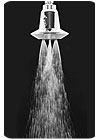
Three major trends are pushing green building to the forefront of the construction industry’s consciousness, according to FMI’s 2008 U.S. Construction Overview:
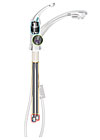
“I am often asked, ‘What makes a product green?’” says Michelle Hucal, LEED AP, editor of Environmental Design + Construction magazine and member of the U.S. Green Building Council board. “The best answer I can provide is suggesting that a ‘green’ product is one that doesn’t harm the environment (such as material that contains no VOCs, conserves water and energy, and/or reduces the impact on landfills); a green building product may even benefit the environment (such as one that purifies water or reuses existing materials).
“Fortunately, there is an assortment of tools and resources, such as third-party certification, available for product and material evaluation, which are often based on a diverse set of criteria ranging from recycled content or recyclability to its impact on indoor air quality or the length of its lifecycle.”
(For a listing of green construction products, take at look at Environmental Design + Construction’s GREEN BOOK, www.edcmag.com/greenbook.)
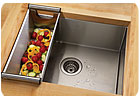
Sustainable Style In Plumbing
Sustainable materials in plumbing can include stainless steel, cast iron, natural stone, marble, aluminum, recycled glass, copper, etc. Manufacturers of kitchen sinks and bathroom lavs use these materials frequently.

Conserving A Critical Natural Resource
Water shortages are becoming reality a for many areas of the United States; a recent government survey showed at least 36 states are anticipating local, regional or statewide water shortages by 2013, caused by a combination of rising temperatures, drought, population growth, urban sprawl, waste and excess.“We’ve hit a remarkable moment,” Barry Nelson, a senior policy analyst with the Natural Resources Defense Council, told The Associated Press last fall. “The last century was the century of water engineering. The next century is going to have to be the century of water efficiency.”
With many localities imposing water restrictions on residents, and tension between those areas that have adequate fresh water supplies and those who do not, water could be the new oil.
The plumbing industry has been working for years on making products that save water. Yes, much of that started with the Energy Policy Act of 1992, which mandated low-flow toilets (1.6 gallons per flush). But advances and innovation have been occurring every year - some driven by the United States Green Building Council’s LEED program - so consumers have the best performing plumbing products using the least amount of water.
Kohler has 1.4-gpf (Class Five), 1.28-gpf (Class Five EST) and 1.1-gpf technologies (Pressure Lite), as well as a dual-flush option (1.4/1.0 gpf - Power Lite) and the Steward waterless urinal. Sloan Valve Co. introduced some new water-saving products at last fall’s Greenbuild show in Chicago, including the solar-powered, dual-flush Solis flushometer and a 1 pint urinal system. American Standard has its FloWise 1.28-gpf high-efficiency toilet, and Gerber has the Ultra Flush and Ultra Dual-Flush models.
Caroma’s dual-flush toilets offer a 0.8 gallon flush and a 1.6 gallon flush, making all its models HETs. And Toto unveiled nine new HETs to the market, all with its 1.28 E-Max flushing technology.
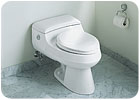
While many consumers (and plumbers!) can recall the debacle of the first generation of low-flow water closets, the industry’s manufacturers have tested and retested to make sure this newest generation of ultra-low-flows deliver the performance as well as the water savings.
Moen recently introduced its Rothbury collection with a water-saving, 1.5-gpm aerator. Neoperl’s Cache aerator cartridge can be hidden in the faucet, can be used in bath or kitchen faucets, and achieves flow rates of 1.5 gpm. Both have been certified by WaterSense. (WaterSense requires faucets to use no more than 1.5 gpm; LEED requires flow rates of less than 2 gpm.)
How about a faucet that guarantees no leaks? That’s what Delta Faucet Co.’s new Diamond Seal technology promises - it reduces the number of leak points because of the closed system. The InnoFlex PEX waterway is part of that system, and also keeps water away from any metal contaminants in the faucet, including lead.
Touchless, or hands-free, faucets - such as Danze’s Parma kitchen faucet - are green because they help keep germs and contaminants from getting on hands while the faucet is being used, but they also save water. The sensor in the faucet only allows water to flow when it detects an object under the faucet. Kohler, Delta Faucet Co., Moen and Elkay also make hands-free faucets.
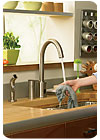
Hansgrohe’s EcoAIR handshower and showerhead uses air-injection technology to provide a flow rate of 1.6 gallons per minute.
Both manufacturers say that these technologies allow for a full-coverage shower, even at the lower flow rates.
What about a steam shower? Steam shower systems - such as ThermoSol, Mr. Steam or Steamist - require only about 2-5 gallons of water to power a steam bath for 20-30 minutes versus 30 gallons of water for a 20-30 minute regular shower.
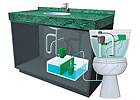
Water Facts
To see the impact of how we use (or waste) water, here are some stats from the EPA’s WaterSense program:
Looking for a reprint of this article?
From high-res PDFs to custom plaques, order your copy today!







